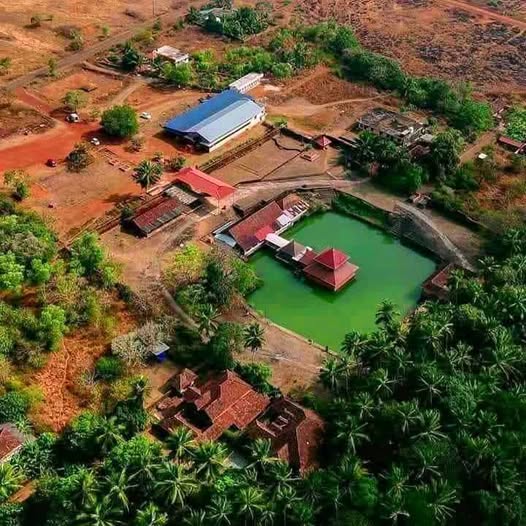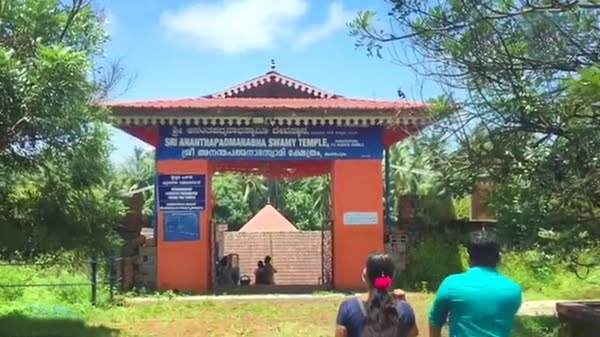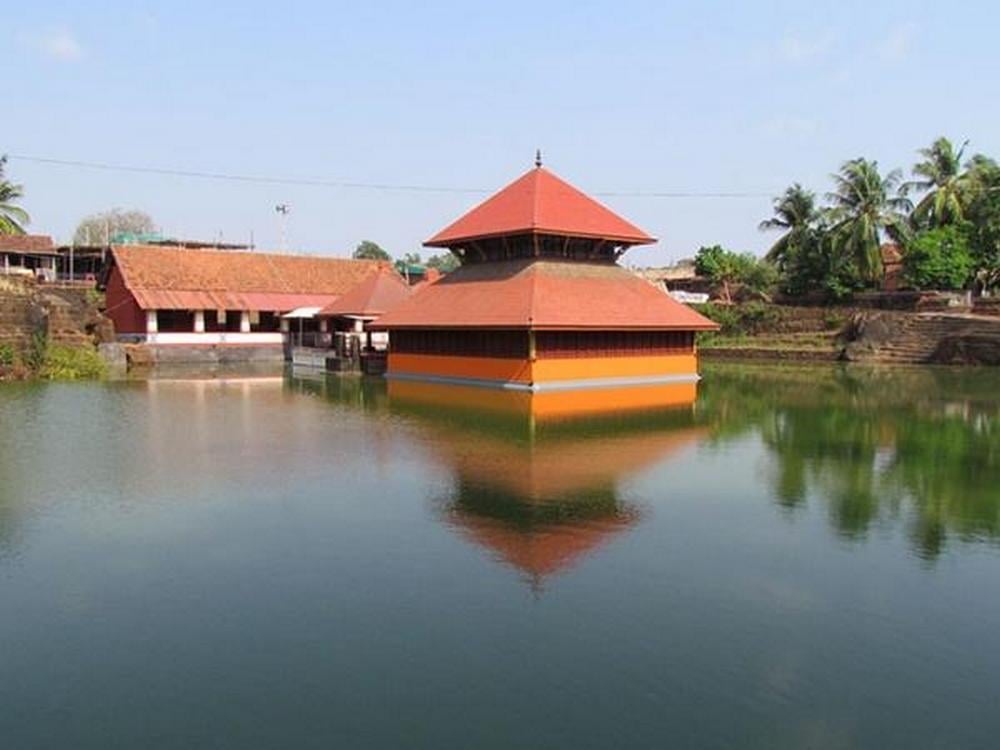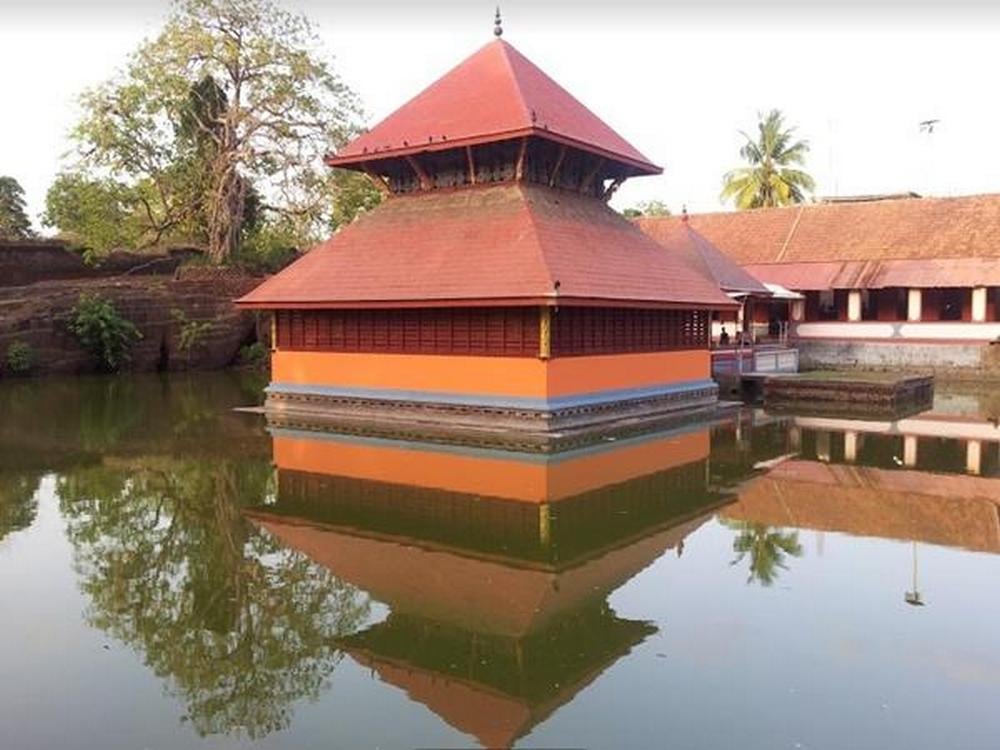Ananthapadmanabhaswamy Temple, also known as Ananthapura Lake Temple, is a unique Hindu temple situated in the middle of a serene lake in the village of Ananthapura, approximately 6 km from Kumbla town in Manjeshwaram Taluk, Kasaragod district, Kerala.

It holds the distinction of being the only lake temple in Kerala and is traditionally regarded as the original seat (Moolasthanam) of Lord Ananthapadmanabha, the presiding deity of the famed Padmanabhaswamy Temple in Thiruvananthapuram.
Revered as one of the 108 Abhimana Kshethrams in the Vaishnavite tradition, the temple is deeply rooted in legends that state this was the very place where Lord Ananthapadmanabha first appeared and resided.
The temple stands within a rectangular lake that spans around 2 acres, adding to its serene and mystical aura. One of the fascinating features here is a cave located on the northern edge of the lake. According to local lore, Lord Ananthapadmanabha is believed to have journeyed through this cave to reach Thiruvananthapuram. This symbolic connection is why both places—Ananthapura and Thiruvananthapuram—share similar names, being linked as the spiritual origin and abode of the same deity. The history of Ananthapura Lake Temple remains largely veiled in mystery, with much of its past preserved through ancient myths and local legends.
One of the most well-known legends involves the revered Brahmin sage Divakara Muni Vilwamangalam, a devout spiritual seeker and saint.
According to the legend, it was at this sacred site that Vilwamangalam Swamiyar performed intense penance and worship. One day, Lord Narayana is said to have appeared before the sage in the form of a radiant young boy. Captivated by the child’s divine glow, Vilwamangalam asked who he was. The boy replied that he had no father, no mother, and no home. Moved by compassion, the sage allowed the boy to stay with him.
However, the boy made one request: if ever he felt humiliated, he would leave immediately. For a while, the child stayed and served the sage, but over time, his mischievous behavior grew too bothersome. Eventually, the sage, unable to tolerate the pranks, scolded the boy harshly. Feeling insulted, the boy vanished after declaring that if Vilwamangalam wished to see him again, he must go to Ananthankadu, the forest of Anantha, the serpent deity.
Realizing with deep remorse that the boy was none other than Lord Vishnu, the sage began a fervent search.
He entered a cave at the very spot where the child disappeared and followed it until he reached the seashore. Continuing his journey south, he eventually arrived at a lush grove near the sea.
There, Vilwamangalam once again beheld the divine boy. This time, the child merged into a massive Illippa tree (Indian butter tree or Mahua). The tree then fell and miraculously transformed into the divine form of Lord Vishnu reclining on the thousand-hooded serpent Anantha—the iconic form of Ananthapadmanabha Swamy.
This powerful vision is believed to mark the origin of Sree Padmanabhaswamy Temple in Thiruvananthapuram, connecting it mystically to Ananthapura Temple, which is considered the moolasthanam or original seat of the deity. The Ananthapura Lake Temple stands out not only for its spiritual significance but also for its unique architectural brilliance. Constructed right in the center of a magnificent lake stretching approximately 302 feet, the temple creates a striking sight, surrounded by the serenity of clear spring-fed waters. This lake, continually replenished by natural spring sources, enhances the temple’s tranquil atmosphere.
Remnants of ancient temple structures scattered around the lake hint that this site was once part of a vast and elaborate temple complex. These ruins speak of the region’s rich spiritual and cultural heritage.
Several key components of the temple—including the Sreekovil (sanctum sanctorum), the Namaskara Mandapam (prayer hall), the Thitappalli (temple kitchen), the shrine of Jala-Durga, and the entrance to the sacred cave—are all built within the lake itself. The Namaskara Mandapam is connected to the rocky eastern shore via a narrow footbridge, which also serves as the only entryway to the inner sanctum.
The presiding deity is Lord Vishnu, depicted in a seated posture atop the five-hooded serpent king Anantha. What makes this idol especially unique is that the original murti (idol) was not made from stone or metal. Instead, it was formed using a rare ancient compound called ‘Kadu-sharkara-yogam’—a sacred blend of over 70 medicinal herbs and minerals traditionally used for idol making in Vedic times.
However, in 1972, these were replaced with idols made of Panchaloha (a five-metal alloy considered sacred in Hindu traditions), a donation by Kanchi Kamakoti Peetham’s Jagadguru Sri Jayendra Saraswathi Thiruvatikal.
Presently, there are ongoing efforts to reinstate the original kadu-sharkara idols, reviving an ancient practice rooted in Ayurvedic tradition. The ceiling of the Namaskara Mandapam showcases intricate wood carvings, illustrating scenes from the Dashavatara—the ten incarnations of Lord Vishnu. Some of these carvings are adorned with vibrant paintings, enhancing their visual appeal. At the Muktha Mandapam, the Navagrahas (nine planetary deities) are painted, reflecting traditional Hindu cosmology.
Flanking the sanctum on both sides stand the divine gatekeepers, Jaya and Vijaya, beautifully sculpted from wood, adding to the temple's artistic richness.
In keeping with the inclusive spirit of Sanatana Dharma, the temple is open to all visitors, regardless of caste or creed. The District Tourism Promotion Council (DTPC) has undertaken initiatives to preserve and promote the temple’s distinctive cultural and architectural heritage.One of the most fascinating aspects of the Ananthapura Lake Temple is the story of Babiya, the vegetarian crocodile who lived in the temple lake for decades. Believed to survive solely on temple offerings served twice a week, Babiya never harmed a human, becoming a symbol of peace and divine grace.
Babiya passed away on October 9, 2022, at the age of 75. Her gentle presence was deeply missed by devotees who saw her as a guardian of the temple.
In November 2023, a new crocodile appeared in the lake. Smaller than Babiya, it too began to show similar peaceful behavior—avoiding fish and accepting temple offerings. Many view this as a divine sign, with the new crocodile seen as Babiya’s spiritual successor, continuing the temple’s tradition of harmony between nature and faith.
അനന്തപുരം തടാകക്ഷേത്രം
കേരളത്തിലെ കാസർഗോഡ് ജില്ലയിലെ ഒരു പ്രശസ്തമായ ക്ഷേത്രമാണ് അനന്തപുരം പദ്മനാഭസ്വാമി ക്ഷേത്രം, ജനപ്രിയമായി "തടാക ക്ഷേത്രം" എന്നറിയപ്പെടുന്നത്. ഭഗവാൻ മഹാവിഷ്ണുവാണ് ഇവിടത്തെ മുഖ്യദേവത, അനന്തശയന ഭാവത്തിലാണ് വിഗ്രഹം പ്രതിഷ്ഠിച്ചിരിക്കുന്നത്. തിരുവനന്തപുരത്തെ അനന്തപത്മനാഭസ്വാമി ക്ഷേത്രത്തിന്റെ മൂലസ്ഥാനമായും (മൂലസ്ഥാനം) ഈ ക്ഷേത്രം ചില ഐതിഹ്യങ്ങൾ പ്രകാരം പരിഗണിക്കപ്പെടുന്നു.കാസർഗോഡിലെ മഞ്ചേശ്വരം താലൂക്കിലെ കുമ്പളയിൽ നിന്ന് 5 കിലോമീറ്റർ അകലെയാണ് ഈ ക്ഷേത്രം സ്ഥിതിചെയ്യുന്നത്.
മനോഹരമായ ഏകദേശം രണ്ട് ഏക്കർ വിസ്തൃതിയുള്ള തടാകത്തിന്റെ മദ്ധ്യഭാഗത്ത് ഈ ക്ഷേത്രം സ്ഥിതിചെയ്യുന്നു. കേരളത്തിലെ ഏക തടാക ക്ഷേത്രമായതിനാൽ ഇതിന് പ്രത്യേക പ്രസിദ്ധിയുണ്ട്. ഇവിടുത്തെ മഹാവിഷ്ണു വിഗ്രഹം കടുശർക്കരയോഗം എന്ന അതി ദുര്ലഭമായ ഔഷധസമാഹാര ഉപയോഗിച്ചാണ് പ്രാഥമികമായി നിർമ്മിച്ചത്. ഇക്കാലത്ത് പഞ്ചലോഹ വിഗ്രഹം ആണ് പ്രതിഷ്ഠയിലുള്ളത്. ആകർഷകമായ ശൈലിയിൽ തീർത്തു നിർമ്മിച്ചിരിക്കുന്ന ക്ഷേത്രത്തിന്റെ ഓരോ ഭാഗവും ചരിത്രത്തിന്റെയും ആരാധനാസംസ്കാരത്തിന്റെയും ആഴമൊളിപ്പിച്ചിരിക്കുന്നു.ഒരു പ്രായം ചെന്ന മുതല ഈ തടാകത്തിൽ കാണപ്പെടുന്നു.
കാസർഗോഡ് ജില്ലാ ആസ്ഥാനത്തുനിന്ന് പതിമൂന്ന് കിലോമീറ്റർ അകലെയുള്ള കുമ്പളയ്ക്കടുത്തുള്ള അനന്തപുരം ഗ്രാമത്തിലാണ് അനന്തപദ്മനാഭസ്വാമി ക്ഷേത്രം സ്ഥിതിചെയ്യുന്നത്, ഏകദേശം 26 മിനിറ്റോളം യാത്രാ സമയം വേണ്ടിവരും. കാസർഗോഡിൽ നിന്ന് ബസ്, ടാക്സി തുടങ്ങിയ വാഹനങ്ങൾ ഉപയോഗിച്ച് ക്ഷേത്രത്തിലെത്താൻ സൗകര്യമുണ്ട്. വിദൂര പ്രദേശങ്ങളിൽ നിന്നെത്തുന്ന ഭക്തർക്കായി ക്ഷേത്രം സമീപത്തുതന്നെ താമസസൗകര്യവും ഒരുക്കിയിട്ടുണ്ട്. തെക്കൻ കേരളത്തിലോ കര്ണാടകത്തിലോ നിന്ന് വരുന്നവർക്ക് കാസർഗോഡ് വഴി സീതാംഗോളിയിലൂടെയും മായിപ്പാടി ശിവാജി നഗറിൽ നിന്നും ഇടത്തേക്ക് തിരിഞ്ഞ് രണ്ടുകിലോമീറ്റർ യാത്രചെയ്താൽ അനന്തപുരം ക്ഷേത്രത്തിലെത്താം, ഇതാണ് ഏറ്റവും എളുപ്പമുള്ള മാർഗം. ക്ഷേത്രത്തിന് അടുത്തായി അനന്തരമായ പ്രകൃതിസൗന്ദര്യമുള്ള അനന്തപുരം കുന്ന് സ്ഥിതിചെയ്യുന്നു.
അടുത്തുള്ള റെയിൽവേ സ്റ്റേഷൻ കുമ്പളയാണ് (ഏകദേശം 5 കിലോമീറ്റർ), ഇവിടെ മംഗളാപുരം–കാസർഗോഡ് പാതയിലൂടെയുള്ള പാസഞ്ചർ, മെമു ട്രെയിനുകൾ മാത്രമേ നിൽക്കൂ. അടുത്തുള്ള പ്രധാന റെയിൽവേ സ്റ്റേഷൻ കാസർഗോഡാണ്. പണ്ട് മുതൽക്കേ ഈ തടാകത്തിൽ കണ്ടുവരുന്ന മുതലയെ ബ്രിട്ടീഷുകാർ വെടിവച്ച് കൊന്നതായിട്ടുള്ള വിവരങ്ങളുണ്ട്. എന്നാല് അതിന് ശേഷമായിരുന്നു “ബബിയ” എന്ന പേരിൽ ഒരു പുതിയ മുതലയെ തനിയെ പ്രത്യക്ഷപ്പെട്ടതായി വിശ്വസിക്കുന്നത്. ഈ മുതല നിരുപദ്രവകാരിയായിരുന്നു. ഭക്തന്മാരോടോ സന്ദർശകരോടോ യാതൊരു ഭീഷണിയും ഉണ്ടാക്കിയിട്ടില്ല.ക്ഷേത്രനിവേദ്യം മാത്രമായിരുന്നു, ആഹാരം . മത്സ്യങ്ങൾയോ മറ്റേതെങ്കിലും ജീവികളെയോ ഇത് വേട്ടയാടിയിട്ടില്ലെന്ന് പറയപ്പെടുന്നു.
Address:
Ananthapuram,
Kumbla (Kumble),
Kerala 671321



